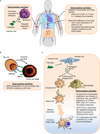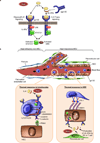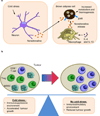Fever and the thermal regulation of immunity: the immune system feels the heat
- PMID: 25976513
- PMCID: PMC4786079
- DOI: 10.1038/nri3843
Fever and the thermal regulation of immunity: the immune system feels the heat
Abstract
Fever is a cardinal response to infection that has been conserved in warm-blooded and cold-blooded vertebrates for more than 600 million years of evolution. The fever response is executed by integrated physiological and neuronal circuitry and confers a survival benefit during infection. In this Review, we discuss our current understanding of how the inflammatory cues delivered by the thermal element of fever stimulate innate and adaptive immune responses. We further highlight the unexpected multiplicity of roles of the pyrogenic cytokine interleukin-6 (IL-6), both during fever induction and during the mobilization of lymphocytes to the lymphoid organs that are the staging ground for immune defence. We also discuss the emerging evidence suggesting that the adrenergic signalling pathways associated with thermogenesis shape immune cell function.
Conflict of interest statement
Figures





References
-
- Celsus ACA. In: Cornelius Celsus of medicine In eight books. Translated, with notes critical and explanatory, by. Greive James., MD, editor. London: printed for D. Wilson and T. Durham; 1756.
-
- Kluger MJ. Phylogeny of fever. Fed Proc. 1979;38:30–34. - PubMed
-
-
Schulman CI, et al. The effect of antipyretic therapy upon outcomes in critically ill patients: a randomized, prospective study. Surg Infect (Larchmt) 2005;6:369–375. References and 4 show that treatment of fever using anti-pyretic drugs has a detrimental effect on patient outcome during infection.
-
Publication types
MeSH terms
Substances
Grants and funding
LinkOut - more resources
Full Text Sources
Other Literature Sources
Medical

